Manila Metropolitan Theater
| Manila Metropolitan Theater | |
|---|---|
| Tanghalang Pangkalakhan ng Maynila | |
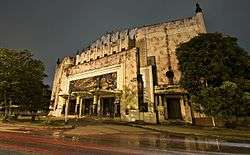 Manila Metropolitan Theater | |
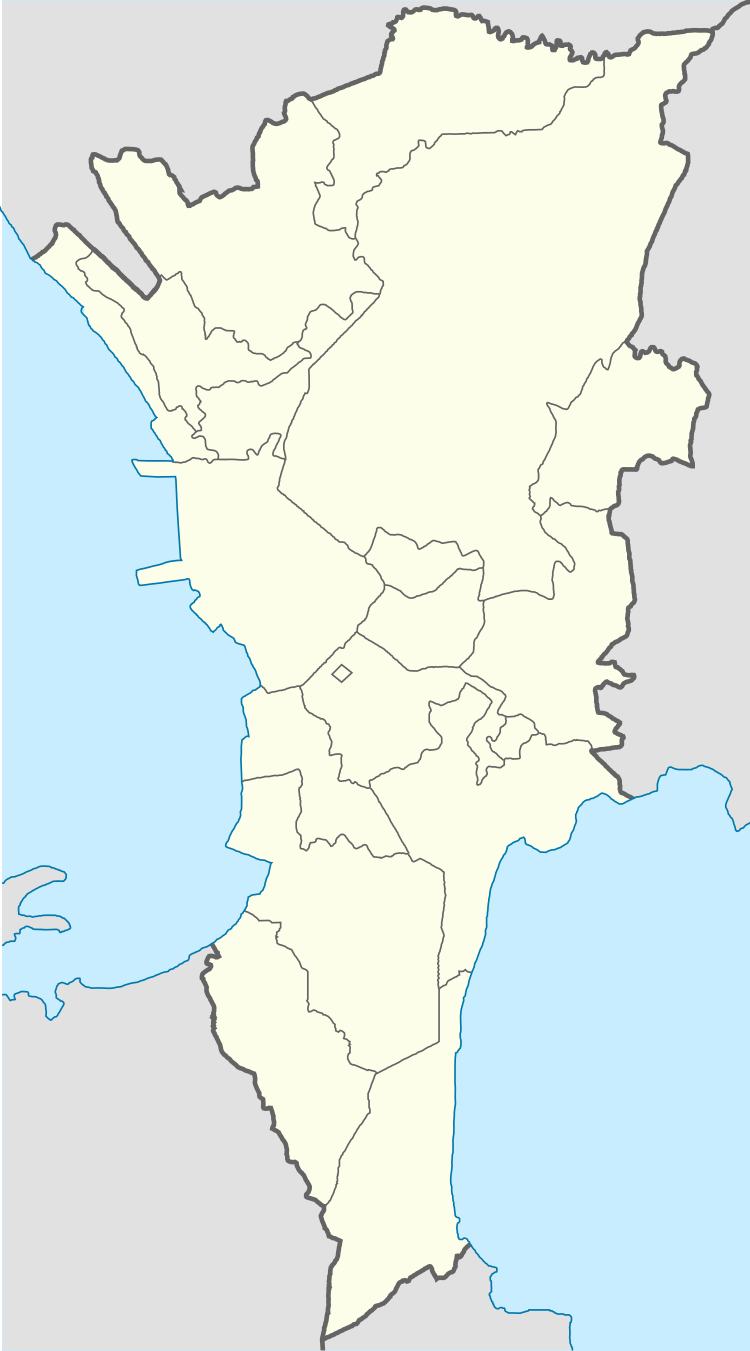 | |
| General information | |
| Status | Under renovation |
| Type | Theater building |
| Architectural style | Art deco |
| Location | Lawton, Manila |
| Address | Padre Burgos Avenue corner Arroceros Street, Ermita |
| Town or city | Manila |
| Country | Philippines |
| Coordinates | 14°35′39″N 120°58′50″E / 14.594205°N 120.980421°ECoordinates: 14°35′39″N 120°58′50″E / 14.594205°N 120.980421°E |
| Groundbreaking | 1930 |
| Inaugurated | December 10, 1931 |
| Renovated | Ongoing |
| Owner | NCCA |
| Technical details | |
| Floor area | 8,239.58 m2 (88,690.1 sq ft) |
| Design and construction | |
| Architect | Juan M. Arellano |
| Civil engineer | Pedro Siochi y Angeles |
| Main contractor | Pedro Siochi and Company |
| Renovating team | |
| Architect | Gerard Lico |
| Other information | |
| Seating capacity | 1,670 |
The Manila Metropolitan Theater (Filipino: Tanghalang Pangkalakhan ng Maynila, or MET) is a Philippine Art Deco building found near the Mehan Garden located on Padre Burgos Avenue corner Arroceros Street, near the Manila Central Post Office. It was designed by architect Juan M. Arellano and inaugurated on December 10, 1931.[1]
Conception of theater
In 1862, the Teatro del Príncipe Alfonso XII was built within Plaza Arroceros, near the present-day Metropolitan Theater. This theater stood until 1876, when the old theater was burnt down.
It was in 1924, during the American Colonial period that the idea of constructing a theater in Manila came about. The Philippine Legislature then approved Senator Alegre’s proposal to build a theater within the Mehan Garden (now Sining Kayumanggi). The construction began in 1930 under the supervision of the engineering firm Pedro Siochi and Company in a 8,239.58 square meter area of the park. It was inaugurated on December 10, 1931. This new theater housed different performances from zarzuelas, dramas to translations of foreign classics.[2]
History of theater
Juan Arellano, one of the first pensionados in architecture, also known for his other major projects such as the Legislative Building and Manila Central Post Office Building, designed the Manila Metropolitan Theater in January 1930. He was sent to the United States to be guided by one of the experts in designing theaters, Thomas W. Lamb of Shreve and Lamb.[3]
The theater’s roof and walls were partially destroyed during World War II. During the post-war period, it was misused as a boxing arena, low-quality motel, gay bar, basketball court and as a home for squatters. In 1978, a restoration of the theater was initiated by the then Governor of Metro Manila Imelda Marcos which was headed by Otilio, the nephew of Juan Arellano.[4] Its prestige as a cultural center was redeemed but proved to be short-lived. It closed down its doors again in 1996 because of conflicts of ownership between the Manila City Administration and the Government Service Insurance System (GSIS). In 2010, President Gloria Macapagal-Arroyo and Manila mayor Alfredo Lim tried to revive the theater but to no avail.[1]
The theater was used again once for a Wolfgang concert in 2011. But since 2012, the theater was closed again due to decays inside the building. The structure continued to deteriorate and vandalism, political advertisements, promotional materials and trash now degrade the heritage theater. The theater has been protected using pieces of wood, scrap electrical wires and rundown plywood. Help continued to pour in but lacked any concrete direction.[5]
In May 2015, the Department of Budget and Management released Php 270 Million from the National Endowment Fund for Culture and the Arts for the sale of the theater from its owner, the GSIS. In June 2015, the GSIS transferred the right of ownership of the theater to the National Commission for Culture and the Arts to start the rehabilitation process of the Met.
Clean-up drives were started in December 2015, paving the way for the eventual restoration of the building by 2016.[6]
It is currently undergoing renovations with Consulting Architect Gerard Lico spearheading the project.
Architecture
The concept of the theater was explained by Juan Arellano during one of his interviews in January 1930.
“The Philippines needed a modern cultural center for operas, concerts, and plays, and he planned to achieve a monumental one through its dimensions, elevations, and splendid decorations, and through its harmonious liens it would symbolize an organ or a cathedral.”
Arellano was influenced by early Filipino art which uses local motifs and diverse imagery of Philippine flora. Aside from his knowledge on Filipino art was the factor of economy which both helped the architect in having a modern design approach to the theater. Meanwhile, the phrase “on wings of song” gave the structural configuration, a box-shaped auditorium flanked by pavilions on both sides. The mix of modernization and romanticization resulted in A. V. H. Hartendrop labeling it as modern expressionism.[3]
The Metropolitan Theater façade resembles a stage being framed by a proscenium-like central window of stained glass which carries the name “Metropolitan” with flora and fauna motif surrounding the label. This helps bring in light to the lobby. It was highlighted on both ends by the curving walls with colorful decorated tiles in resemblance with the batik patterns from Southeast Asia. There are also moldings of zigzag and wavy lines that go with the sponged and painted multi-colored massive walls. The wall that framed the stained glass is a segmented arch with rows of small finials on the upper edge of the wall.[3] Angkor Wat-inspired minarets crown the top of the concave roof which suggested its status as a theater back in its prime days. Located in the entrance are elaborate wrought iron gates which are patterned into leaf designs and various lines. Accenting the ground level are Capiz lamps and banana-leaf formed pillars which go alternately with the theater’s entrances.[1]
- Close up of the art deco ornaments of the Metropolitan Theater
- Manila Metropolitan Theater Entrance Facade
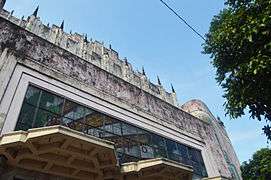 The main facade with the glass mural and other decorative elements
The main facade with the glass mural and other decorative elements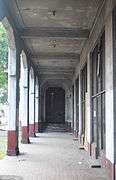 Arcade
Arcade A sculpture at the topmost part
A sculpture at the topmost part Typical bay
Typical bay Play of levels of massing
Play of levels of massing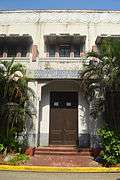 Side entrances
Side entrances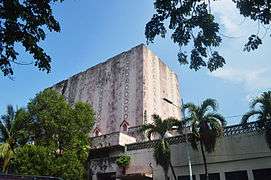 The theater block
The theater block Organic ornaments
Organic ornaments View from the foot of Quezon Bridge.
View from the foot of Quezon Bridge.- The Theater from the air
Standing at the back is a huge vertical box decorated on the sides by geometric motifs. The ceiling profile of the auditorium was reflected in the exterior through stepped vaults.[3]
There were different artists who collaborated in this project especially inside the theater. Located at the main lobby were sculptures of Adam and Eve done by Francesco Riccardo Monti,who resided in Manila from 1930 up to his death in 1958.[7] Isabelo Tampingco, a Filipino artist designed the Philippine plant-themed carvings in the interior spaces including the lobby while National Artist Fernando Amorsolo painted the murals The Dance and The History of Music located at the ends of the balcony. The grillwork on small balconies looking out into the foyer was exceptionally elegant transitions from Art Nouveau to Art Deco, expressed by Lourdes Montinola in her book.[1] The two black posts at the bottom of the staircases were decorated with glass mosaic tiles.
The main auditorium projects a different character as compared to the building envelope’s ornamentality. A sequence of gradually lowered arches made of local wood, enhanced by panels with colorful motifs. These motifs were a combination of mangoes, bananas, and foliage painted by the brother of Juan Arellano, Arcadio. On top of the proscenium are figures symbolic of Music, Tragedy, Poetry and Comedy. Resembling bamboo stalks are the tapering lamps of translucent glass which surround the theater space.[1] The focal point is the rectangular stage adorned with mango fruits and leaves motif.[8]
The crystal lamps made from bamboo stalks which vertically light up the hall are the first in the country in terms of indirect lighting. It is also a new character of Art Deco during that period. The theater, according to some people has good acoustics and lighting and a large seating capacity of 1,670 (846 orchestra, 116 in loge, and 708 in balcony) which housed performances, operas, concerts, and plays for more than a decade.[9] It also continued up to the Japanese occupation where Zarzuelas, Filipino operas, films and stage were shown.
Events hosted
The Manila Metropolitan Theaters housed performances by international artists like Ted Shawn, Jascha Heifetz, Amelita Galli-Curci and Fritz Kreisler and local shows such as the “Smiles of 1936,” “Querer Ranchero” and “Luisa Fernando” were all part of the decade that followed its inauguration.
The first cartoon featuring Mickey Mouse in the Philippines was screened in the theater and the first film of LVN Pictures, Giliw Ko premiered in the theater on July 29, 1939, a screening attended by then-President Manuel Quezon.[10]
It was still active during the Japanese occupation showing support even for the guerrilla underground.[2] The concert of the Manila Symphony Orchestra was cancelled because the performers ran away from the Japanese.[11] The Metropolitan Theater has not been used for a long time.
Other shows that took place in the theater were:
- Metro Manila Film Festival Awards Night (1975-1980, 1984, 1995-2000)
- Jesus is Lord Church Sunday Service (1981-1989)
- Vilma Variety Show (1987-1990)
- Awit Awards (1991)
- PMPC Star Awards For TV (1991-1995)
- Ibong Adarna Musical Play (1994)
- Romeo and Juliet (1994)
- Florante At Laura Musical Play (1994)
- Noli Me Tangere Musical Play (1995)
- El Filibusterismo Musical Play (1995)
- Wolfgang Live At The MET (2011)
References
| Wikimedia Commons has media related to Manila Metropolitan Theater. |
- 1 2 3 4 5 Montinola, Lourdes (2010). Art Deco in the Philippines. Manila: ArtPositAsia. ISBN 978-971-057-905-1.
- 1 2 de la Torre, Visitacion (1981). Landmarks of Manila: 1571-1930. Makati: Filipinas Foundation, Inc. pp. 94–95.
- 1 2 3 4 Lico, Gerard (2008). Arkitekturang Filipino: A History of Architecture and Urbanism in the Philippines. Quezon City: The University of the Philippines Press. pp. 336–337. ISBN 978-971-542-579-7.
- ↑ Alarcon, Norma (2008). The Imperial Tapestry: American Colonial Architecture in the Philippines. Manila: University of Santo Tomas Publishing House. p. 138. ISBN 978-971-506-474-3.
- ↑ I-Witness, GMA-7. (July 13, 2013). "Kasaysayan at Misteryo ng Manila Metropolitan Theater, aalamin sa I-Witness"
- ↑ Nabong, Pat (13 December 2015). "Restoring the MET, reviving culture". Rappler. Retrieved 17 December 2015.
- ↑ Sculptural treasures by Francesco Riccardo Monti - 1INQUIRER.net, Philippine News for Filipinos Archived 2012-02-12 at the Wayback Machine.
- ↑ Coconuts Manila. (February 11, 2014). 15 Heritage Buildings that Need to be Rescued.
- ↑ Tiongson, Nicanor (1978) Reopening souvenir of the Metropolitan Theatre during President Ferdinand Marcos
- ↑ "Inside The Manila Metropolitan Theatre Restoration". Philippine Tattler. Edipresse Media Asia Ltd. 16 May 2018. Retrieved 16 May 2018.
- ↑ Pablo A.Tariman. New MSO Season Opens June 5.
